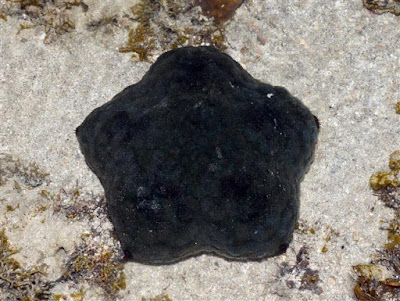We are back on the reefs of Terumbu Bemban! It's one of the submerged reefs in our southern waters that is home to lots of corals.
Here's a look at the sun peeking out from the horizon after we landed. Clear weather means a hot scorching day ahead!
Indeed, very soon we were enveloped by solar rays which cast good light on the rich hard corals situated by the edge of the reef. Many of us are just fixated at looking at these corals and as a result we didn't move much the entire trip.
Here's another look at the packed corals found near the reef edge. What are those sticks at the back?
Terumbu Bemban in Malay is translated as Reef of Fish Trap. How apt it is that this shore has a huge triangular fish trap structure (made up of these sticks) with some remains of fish nets that have now been encrusted. These sticks have become a permanent feature of Terumbu Bemban, reminding us of its past where it was surrounding by fishing villages from nearby islands.
It was nice to come across huge colonies of the Acropora corals (Acropora sp.) which are only abundantly found on pristine reefs such as the one on Raffles Lighthouse.
Unfortunately, some of the Mushroom corals (Family Fungiidae) such as this Tongue mushroom coral (Herpolitha sp.) and Circular mushroom coral (Fungia sp.) show signs of bleaching.
Otherwise, most of the other corals are doing alright and still retain their photosynthetic algae which gives the hard corals their colours. Here's an underwater shot showing corals with a red Barrel sponge (Xestospongia testudinaria) in the middle.
A special find underwater beside the Pebble coral (Astreopora sp.) would be my favourite Cushion star (Culcita novaeguinea)! It's pretty in green.
However, when I took a higher resolution photo using my DSLR, it looked more black instead.
Jianlin and I saw this jellyfish that some of us came across at Kusu Island. Nicholas suggested that this is possibly a Ribbon jellyfish (Chrysaora sp.).
The Stonefish sea cucumber (Actinopyga lecanora) is one of the most common sea cucumber species that we find on coral reefs and coral rubble.
I managed to stumble upon two juvenile versions of the above sea cucumber and they look more orangey than the brown coloration for adults. It is possible that the smaller unidentified orange-red ones are juvenile versions of the brown adults.
We seldome see the orange version of the Wiggly reef star anemone. It is very shy and disappears instantly at the slightest sign of danger.
On the sand bar, I found some of these uncommon Spotted moon snails (Natica gualteriana). As the name suggests, they can be identified through the spots on their body.
Mei Lin, our giant clam expert, was around to survey her darlings. Though she couldn't find the recorded Fluted giant clams (Tridacna squamosa), Mei Lin located two new Burrowing Giant Clams (Tridacna crocea)!
Here's the second and slightly larger one that she found on the other side of the patch reef.
Ending off this post, I thought would be good to reveal a perspective of how it is like for us to don our life jackets and prepare to depart on the dinghy before the tide comes back to "reclaim" back the reefs of Terumbu Bemban.
That's the end of this tiring series of low tides. Will be back soon with more adventures!
More photos of the trip on my facebook album:
https://www.facebook.com/media/set/?set=a.10153428823588158.1073741884.547198157&type=1&l=5f78e82253























No comments:
Post a Comment